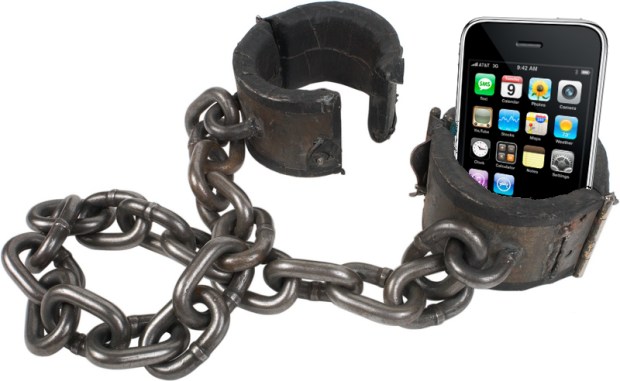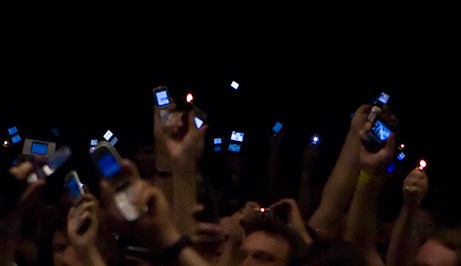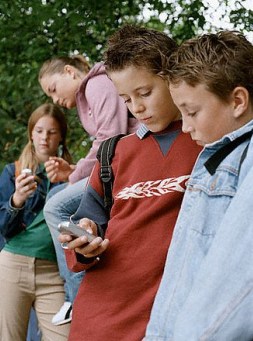
Here’s a phrase many of you will remember, probably from the late 1990s: “Yeah, I’d get a cell phone, but I don’t want to be on, like, an electronic leash, you know?” People had land lines, pagers, car phones — the pocketable mobile phone was still a luxury and, to some, an unwanted responsibility. Over the next 10 years or so, the mobile phone gradually reached such high levels of market penetration that it’s quite difficult to find anybody without one. It is simply too practical and affordable to refrain from at this point. However, in the last few years, as smartphones and texting have become the default mode of communication for many people, the tone has changed again; the electronic leash is returning.
Why is this? It’s actually pretty simple: once a tool reaches a certain level of integration with the social and communication norms of a person, it receives the same level of cognitive consideration as, say, speech. Do you wonder whether you should end a text message with an exclamation mark, a period, or nothing at all? This is because texting and email are approaching the same level of integration with our daily lives as the speech and gestures we’ve been using for millennia. I realize one could have said this at any time over the last decade, but I’m saying it now for a specific reason.
As someone who works online, I have a bit of an unusual communication situation, to be sure. Most of my interactions take place via text boxes. IM, email, the CrunchGear chatroom and task manager where we administer the site — these are my main methods of social interaction during most of the day. Even at my previous job, where I worked in an office and spoke to clients regularly, the volume of email and otherwise written communication approached that of “real” interaction. I’m sure, dear reader, if you were to submit your life to this analysis, you would also find a startling amount of what people like to categorize separately “virtual” (or some such descriptor) communication.
Now, the level of expression possible in 140 characters, or a two-paragraph email, or in a chatroom, is clearly not equal to the level of expression possible in a face-to-face conversation. That is a fact, as far as it goes… partially because our brains are actually designed for the latter sort of interaction, so it’s not really a fair fight. And although the expressive bandwidth, if you will, of a series of text messages is very small, we are beginning to imbue these impersonal, telegraphic communications with the subtlety and power of a normal conversation. You see? As text begins to more completely supplant conversation, conversation more completely informs how we create and interpret the text. Observe this overly simplistic diagram that took way too long to make:

This is, I believe, why our phones are beginning to be electronic shackles yet again. Oh, I don’t mean that because we can write a :) or :(, it’s just like looking in someone’s face — but what was impersonal only a couple years ago is rapidly becoming extremely personal, as we project ourselves more completely onto it, as we must necessarily when it takes up such a large portion of our social interactions. Think of the way correspondence made up such a huge portion of communication before the age of the computer. The Victorians, my god! Half their life was in trunks of letters, and lovers of 19th-century literature will recall the minuteness with which letters are scrutinized; it was at least as important a form of communication as face-to-face conversation, and it got the weight it deserved. Similarly, the delimiting of microcommunications like texts and tweets over the last few years (socially and monetarily) has put them more firmly on our cognitive maps.
So why is it suddenly a shackle, then? Have things really changed so much in the last year or two? Well – it’s an ongoing process, obviously. The best way to see it in action is to hearken back to when BlackBerrys started getting popular. People were glued to them, because as major email users and connected people in general, they were the early adopters not just of the technology, but of the repercussions of relying on that technology. So you’ve got CrackBerrys blowing up, and then you’ve got the iPhone and the popularization of the smartphone that it brought. Over the last couple years, many more phones have integrated push email, instant notifications from things like Facebook and Foursquare, and so on — to say nothing of the increasing popularity of unlimited texting. The reliance on the phone as primary (or close secondary) method of communication is an expanding circle, and it’s starting to envelop the “man on the street,” whereas not long ago it was only the tech-savvy guy, or the business guy, or what have you. The personalization of impersonal communication is happening on a large scale, and the implications of that are interesting.

I say “interesting” because it’s hard to say they’re important, or huge. They’re just that: interesting. The change from phone as passive receptacle of information to active conduit between you and everyone you know means that what the earliest adopters in the 90s feared is coming true. Once a text message or email is as immediate, personal, and important to a group of people as face-to-face conversation, that means by definition that everyone you know can address you at any time, with the reasonable expectation of response.
After all, you don’t just turn away from someone’s face when they’re talking about something uninteresting at a bar, or if they invite you to an event you can’t make it to or don’t want to attend. You nod politely, make excuses, change the topic — all the skills of conversation come into play, because that person is right there and you can’t ignore them, or rather to ignore them is itself a positive act (that is to say, not simply inaction but deliberate inaction). Well, it’s getting to the point where to ignore a text message, email, or evite is also a positive act. How many times have you seen recently someone angry that another person didn’t text them back, or on the other hand, say disdainfully “I’m not even going to respond”?
In other words: our phones no longer simply make us available, as they have for years; they make us present. As close to physically present as corresponds to your level of reliance on the phone. A bit weird, isn’t it?
 For the younger generation, this will be even more pronounced. This isn’t a bad thing at all, I should say: people complain loudly about how kids are texting each other all day and not really communicating. Okay, grandpa — I won’t take any wooden nickels, either. This method of communication is new, and we’re adapting to it as best we can, but just like the parents of my generation deplored the constant phonecalls (imagine the fortune telecoms made on second lines) and their parents deplored the baby boomers’ obsession with… I don’t know what, cruising in your hot rod maybe? Free love? I’m out of my depth. But you get my drift: the communication paradigm is changing, not for the worse, just for the new.
For the younger generation, this will be even more pronounced. This isn’t a bad thing at all, I should say: people complain loudly about how kids are texting each other all day and not really communicating. Okay, grandpa — I won’t take any wooden nickels, either. This method of communication is new, and we’re adapting to it as best we can, but just like the parents of my generation deplored the constant phonecalls (imagine the fortune telecoms made on second lines) and their parents deplored the baby boomers’ obsession with… I don’t know what, cruising in your hot rod maybe? Free love? I’m out of my depth. But you get my drift: the communication paradigm is changing, not for the worse, just for the new.
So I call our phones shackles, and then I say it’s not a bad thing. Well, it’s not a good thing, either — it’s just a thing. You’re “shackled” to your neighbors and your city. You’re “shackled” to your car payments and your futon. But you’re also “shackled” to your kids, your computer, your hobbies. Not every shackle has a ball and chain on the end — it’s just another name for attachment. This new shackle, a shackle of constant connection with the people in your life, is, like most technologies, neutral. In D&D terms, it’d probably be chaotic neutral, since it’s disruptive to the way we’ve been living, but neutral nonetheless.
What are the implications? Beats me, I’m a blogger, not a sociologist. Different implications for different people, probably, or none at all since the change is so gradual and natural as to be imperceptible. But see it or not, the change is happening, and the urgency and primacy of once-virtual communication is mounting as, increasingly, the virtual becomes indistinguishable from the real.